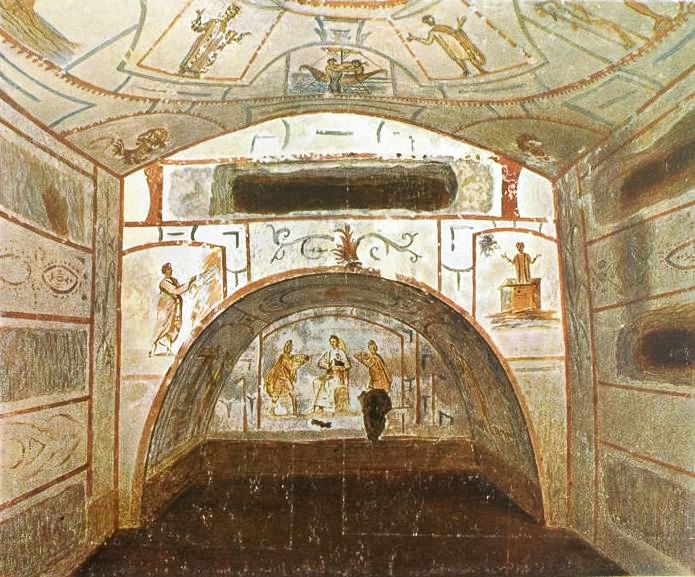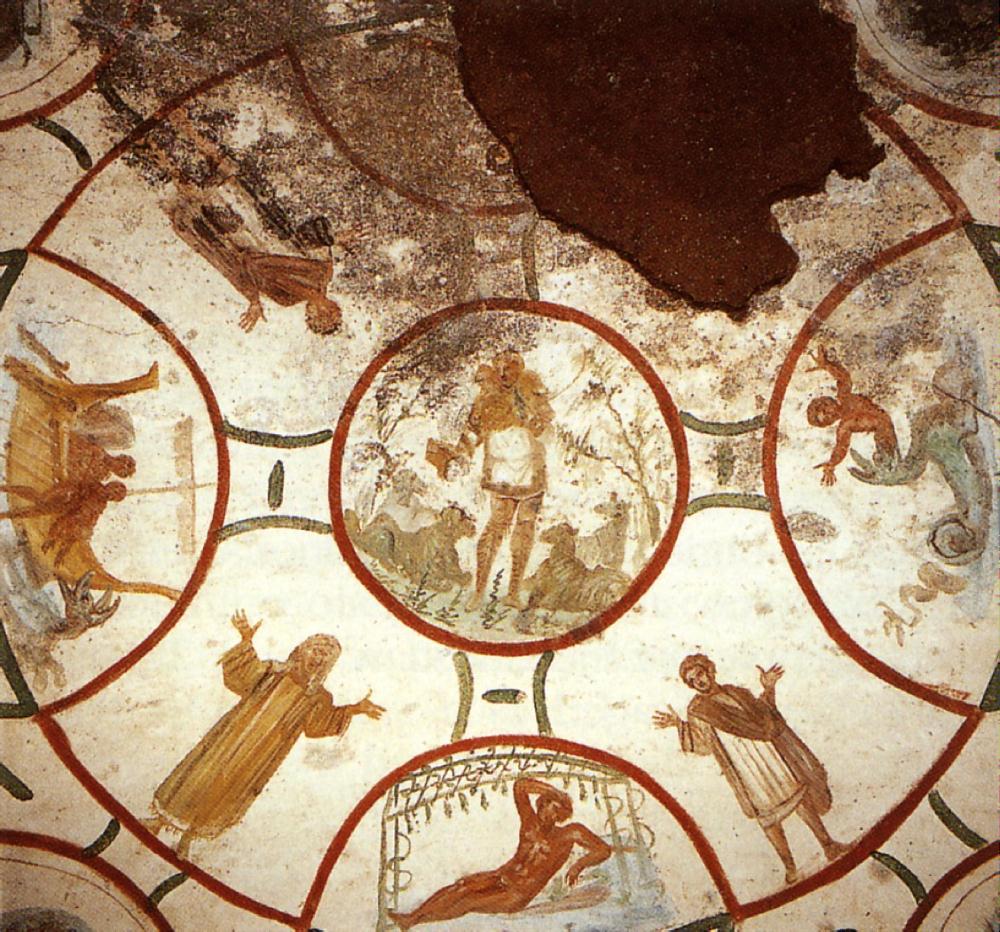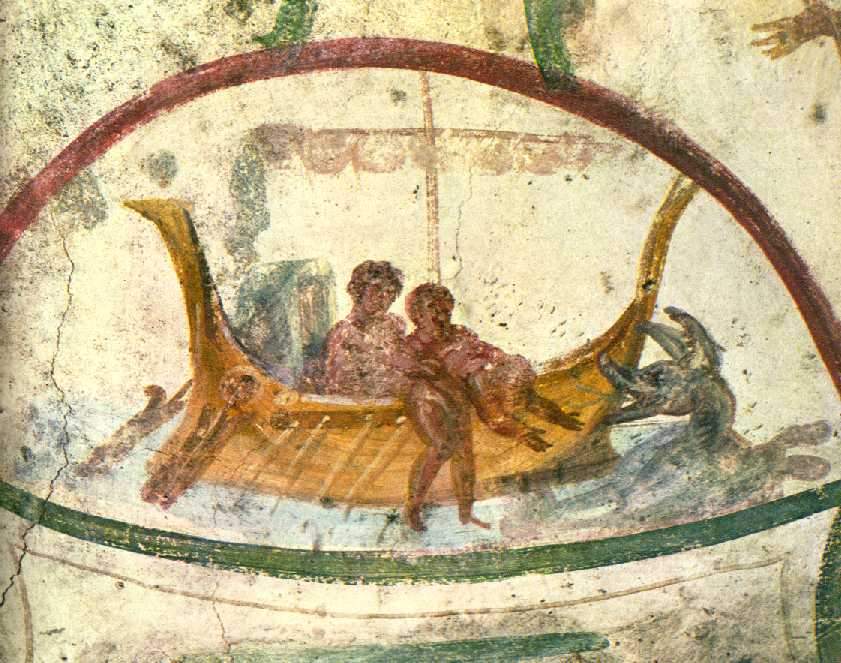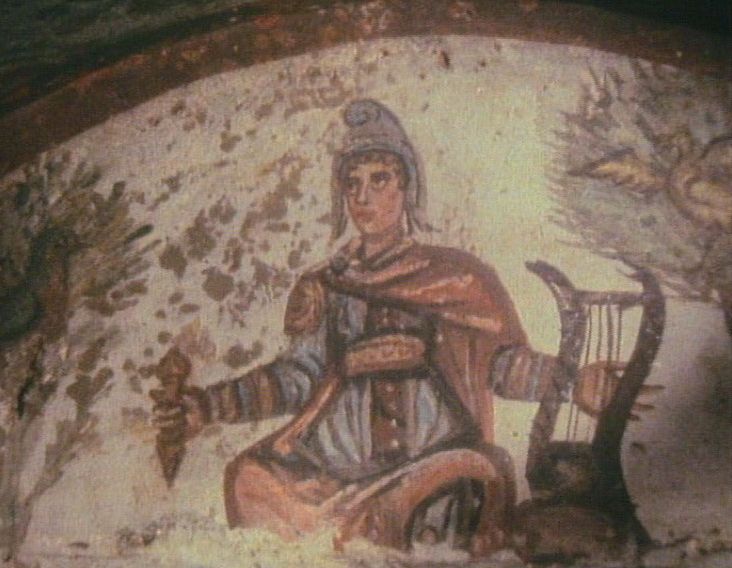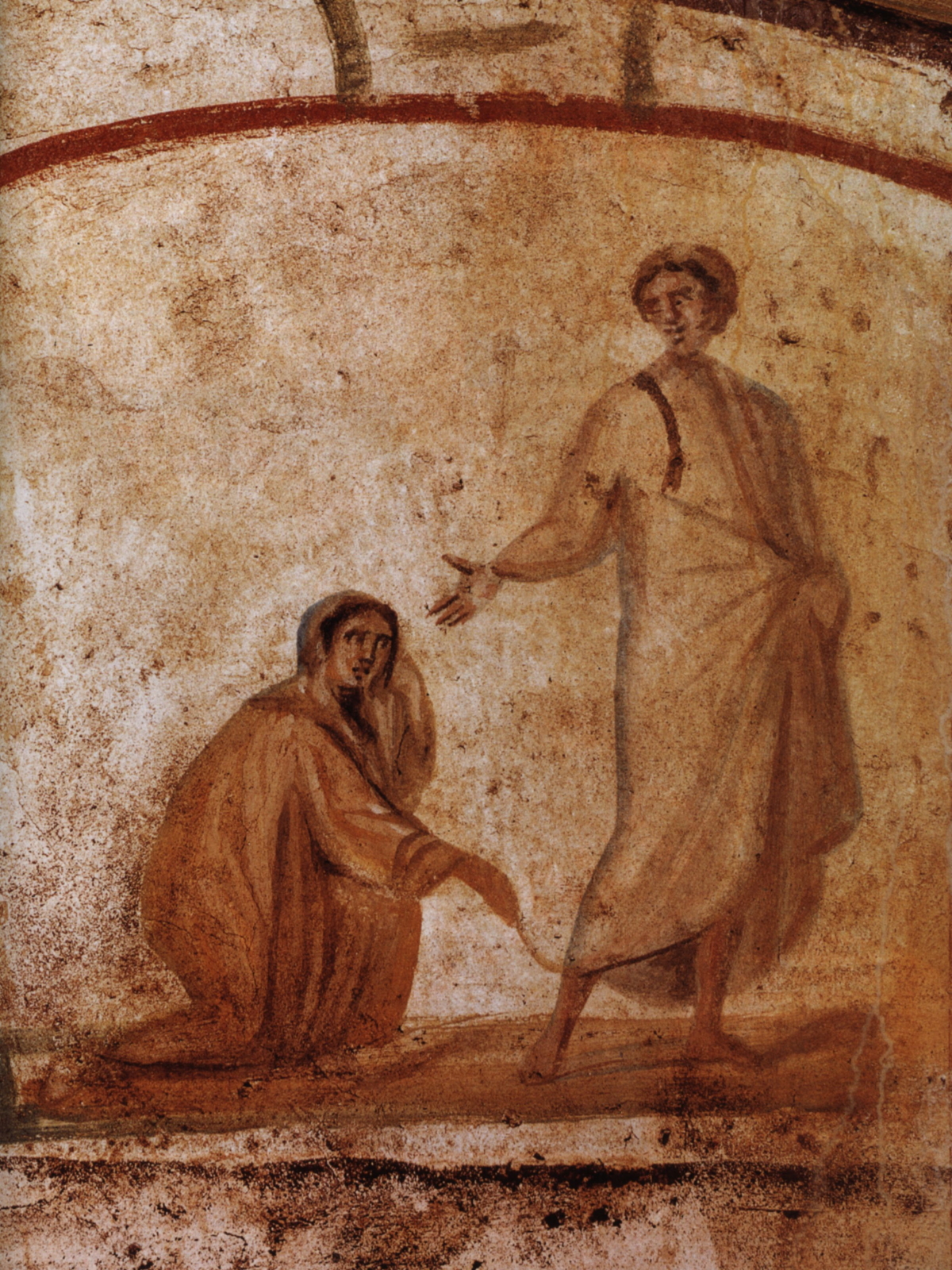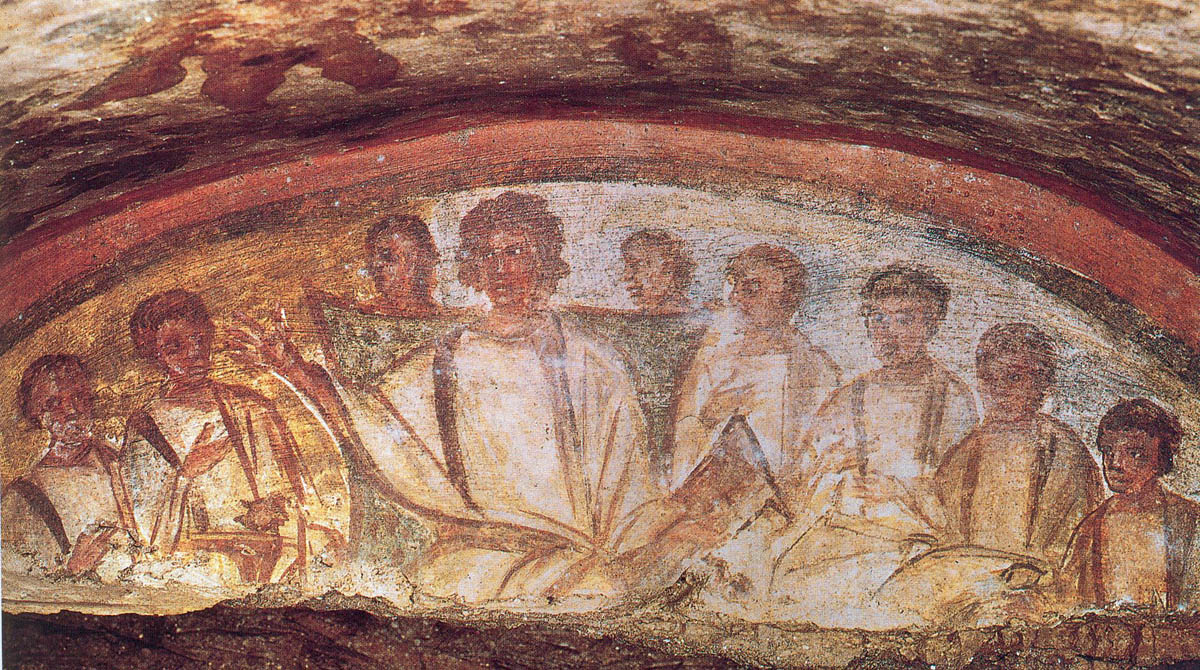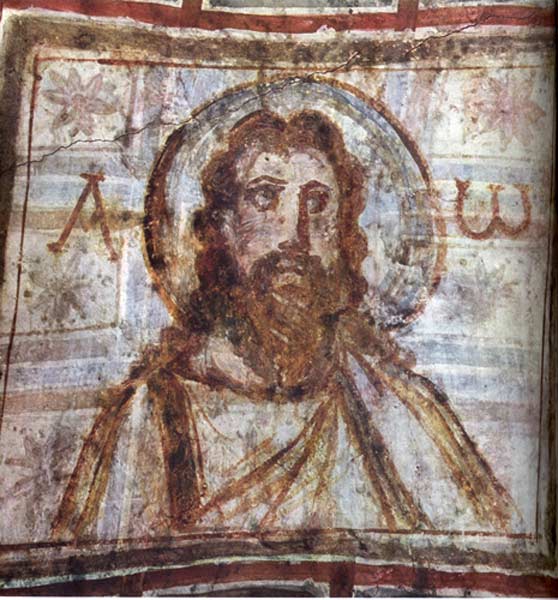4. THE FORMATION OF CHRISTENDOM

THE EARLY CHURCH

THE EARLY CHURCH
 The Gospel of Jesus Christ is brought to
The Gospel of Jesus Christ is brought tothe larger Greco-Roman world
 The actual development of the New
The actual development of the New
Testament canon
 Christianity's impact on the Greco-
Christianity's impact on the Greco-
Roman-Judaic world
 The early definers and defenders
The early definers and defenders
("apologists") of the faith
 Early dissenters from the widely-held or
Early dissenters from the widely-held or
"Catholic" view
The textual material on the page below parallels my work found in
A Moral History of Western Society © 2024, Volume One, pages 132-140 ... although the page below generally goes into much greater detail.
THE GOSPEL OF JESUS CHRIST IS BROUGHT TO THE LARGER GRECO-ROMAN WORLD |
|
Modern skepticism about the recorded life and works of Jesus
It's easy to say, as many skeptics have done – a recent example being the 1980s-1990s "Jesus Seminar," which sought to highlight the "historical Jesus" – that the early church found it convenient to read all these developments back into Jesus's and his disciples' ministries after the fact, to give rationale for the shameful loss of their beloved leader on a Roman cross. There are, they say, no "facts" to validate these many early Christian claims about Jesus. But the skeptics themselves can offer no facts that validate their opinions either. And the mere coincidence of the self-interest of the apostles and other witnesses with these aspects of Jesus's life does not prove a tampering with the facts as given. Preserving the pleasant – and unpleasant – truths
The fact that the disciples never understood this agenda of atonement during Jesus's lifetime does not flatter these individuals. They come off looking petty and foolish. Peter's denial to a woman that he had ever had anything to do with Jesus – while his leader was undergoing humiliating cross examination by the Jewish authorities – was hardly something that anyone later trying to promote the Christian movement would have wanted to be remembered about its leadership. The way Jesus's disciples had so clearly demonstrated themselves to be utter cowards, nearly all of them abandoning Jesus at the time of his arrest and death, would later be a matter of great shame. Thus given the opportunity of his followers (now become the new leaders of this ongoing messianic religious movement) to clean up these stories at a later time, it seems strange that they let these stories stand in all this unflattering light. But none of them seemed to have had any interest in "cleaning up" the story. This attests well to the idea that Jesus was honestly represented by the stories told about him (and about themselves) by his followers. The testimonies of faith
Even though some of the stories told of Jesus by his followers seem unbelievable by modern standards, these stories must be understood as an honest effort of highly transformed people to explain the true source of their new power in life. These are the truths of faith – not fact. And powerful truths these are – as powerful as the faith that transformed their lives from slavery in the world's ways to an incredible personal freedom in and through their trust in God through Jesus Christ. By the gift of this new faith they understood how Jesus was indeed the long awaited Messiah, the Son of God, the one promised by the prophet Isaiah who would redeem them from their sins, reunite them with God, their true heavenly Father, and bring them into the promised Kingdom. This was the ultimate Truth of their lives. The modern bias in seeing "truth" and "fact" as one and the same
This is not the time and place to get into a huge metaphysical debate about the proper relationship between truth and fact (the issue was heavily debated by the ancient Greeks – and it is still heavily debated today by philosophers and scientists). We will look at this issue more closely later in this study. But we certainly have reached the point at which we need to mention that the modern tendency to view fact and truth as one and the same is loaded with logical errors – ones that our secular world blissfully ignores. Even the great modern Relativity Theorist Einstein – and his Quantum Theorist friends – were very aware of the dangers of assuming that what we view as "fact" is indeed "objective reality." "‘Reality out there somewhere" is not obtainable without some cultural or "world view" or "faith"" assumptions … which of course mean that what we view even as "fact" is a highly interpretative matter. What we "see" is actually only a mental reconstruction, tremendously affected by the limited ability of our senses (even aided by modern technological devices) … and by the way culture has taught us to see things. Modern Christianity itself has fallen into secularist thinking – to the extent that it has attempted to defend on a factual basis what was recorded in the Christian scriptures. Both the criticisms of biblical "fact" by the secular world and the "factual" defense of scripture by the (fundamentalist) Christian world miss the point of scripture entirely. Fact does not stand apart from faith – and failing to understand the faith basis of first century Christians makes modern factual interpretation absurd – for both Christianity's skeptical opponents and its misguided defenders. Scripture is simply – but powerfully – the recording of the truth of faith, faith as it functioned in the Palestinian-Hellenistic world of the first century. But it is the closest witness we have to truth to go by ... and therefore in our quest for Christian truth, best understood in the cultural-historical context in which that witness was originally laid forth. In understanding this first century context, we will best understand the truth of Christianity. Early carriers of the Gospel to the larger Greco-Roman World
In any case, the story of Jesus the Christ did not long remain merely a Palestinian story. It soon began to be told around the Roman empire – carried by those who truly felt themselves, and the world, transformed by this strange event. Needless to say, in moving from its Palestinian Jewish roots to the broader Hellenistic Jewish setting, even the Gentile setting, the story (Gospel) got translated in such a way that it might be more readily understood within the larger Hellenistic culture. 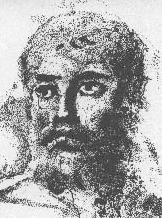 Interestingly, in his collected letters to the various churches that he had either founded or greatly influenced, he mentions almost nothing about the actual life of Jesus. Rather, he reflects on Jesus as a covenant sign of God's doings on earth. In Paul's early writings (the letters to the Thessalonians) he emphasizes the return of the Lord Jesus (the "Day of the Lord') as a great act of cosmic judgment on all creation. But his later writings switch emphasis to the spiritual efficacy of faith in Christ as the Atoning Sacrifice for our sins, the power of God's Spirit given to those who live under the Lordship of Jesus Christ, and the unique role of the new church, the "Body" of the "Living Christ" in an unfolding of Divine history. But undoubtedly most important of all, it was Paul that challenged the early Christian leaders at Jerusalem (Peter and Jesus's brother James), the latter who felt that the community of Christ should be reserved just to Jews … at least until the work of bringing all of Israel to Christ should be completed. But Paul argued strongly that the gospel of Jesus Christ belonged to all – Greek and Jew alike - and thankfully won the argument, thus opening the Christian movement to non-Jews. This would be a Pauline victory of monumental proportions!  The Gospel testimonies themselves
(Matthew, Mark, Luke and John) As none of Jesus's disciples or immediate followers were scholars or writers (fishermen, mostly), what we today possess in the form of the written as biographies or testimonies about Jesus and his ministry were obviously later distillations of the verbal accounts offered by those who knew Jesus personally. The Gospel of Mark. The earliest of those accounts, in Greek (as all the gospels happened to be) was the one we know as the Gospel of Mark, most likely first formulated around the time of the destruction of the Second Temple at Jerusalem in 70 AD. Although it appears as a biographical history, actually it is more a sermonic attempt to explain Jesus in Messianic terms to a Greek audience – using illustrative events, especially miracles – at a time in which the larger context (the current Jewish-Roman War) seemed to indicate the likelihood of a coming "end times." It also seemed to have a large role to play in Rome (in support of Peter's ministry there?) where Mark's Gospel was used liturgically (read in worship) as a declaration of faith: faith in the One who was soon to return in Judgment – as the empty tomb implied. The Gospel of Mark was possibly supplemented by another Secret Gospel of Mark, lost to us today, which was accessible only to the "initiates": those baptized and entitled to share the Eucharist meal of the body and blood of Jesus Christ. The Gospel of Matthew was probably originated soon after the Gospel of Mark, containing much of the same material … although adding its own material, plus a source (today termed "Q") that would be shared with Luke. Mathew is clearly biography, devoted to showing from birth to death and subsequent resurrection, that Jesus fulfilled precisely the Jewish Messianic mandate. Indeed, although written in Greek, Matthew was designed to be received by an audience Jewish in background … not so much to convert Jews (his audience was obviously already Christian in identity) as to help hold a Christian faith more closely to its Jewish roots … as it moved deeper into a Hellenistic world. The Gospel of Luke is actually Part One, focused on Jesus's life and ministry, of a two-volume series … Part Two (The Acts of the Apostles) then being the story of the formation of the early Christian community – also up to around the time of the outbreak of the Jewish Roman War in 66 AD. Both volumes are self-attested as derived from the personal research of the physician Luke, who was a companion to Paul in his missionary work. Like Matthew, the Gospel portion of the series builds in part on Mark, plus information shared with Matthew, plus material exclusive to Luke. And like both other gospels, it probably experienced further development, most likely coming to the form we have today around the end of the first century. The Gospel of John, seemingly put together a bit later, was itself also part of a larger literary grouping, which included also the three Letters of John and the book of Revelation. Early Christian tradition identified the author ("the disciple that Jesus loved") with John, the brother of James, both members of Jesus's inner group of 12 disciples … though there is no way of verifying this. Indeed, the high level of Greek employed would have been rather uncharacteristic of one who was originally an Aramaic-speaking fisherman. On the other hand, although clearly the Johannine writings went through a lengthy refining process, the straightforward stories about Jesus and the precise details of seven of his key miracles as Messianic "signs" – which indicate an intimate familiarity with Jesus and his ministry – could certainly have originated with the disciple John. We do know that John was reportedly the only disciple not to suffer Roman execution for his faith (though he faced a life of continuing imprisonment) and lived to an old age – and it was at that point that he was reputed to have put down his own reflections on the meaning of the life and death of Jesus the Christ. In any case, the Gospel of John (and the Johannine literature in general) reflects a highly developed philosophical mindset, one rather deeply familiar with Greek philosophy. The writer employs the philosophies of Plato and the Stoics as he built his narrative on the understanding that Jesus was the Divine Logos – the perfect representation of the essence of God. The Logos was understood to be the very mind of God and consequently with God from even the beginning of all creation. And now most importantly, this Logos was found fully within Jesus – so that the person of Jesus and the person of the Logos were indistinguishable. John did not explain how this came to be: he merely posited it as being so – by God's doing … unlike the miraculous birth accounts of Matthew and Luke which set out to explain the source of Jesus's divinity in his birth. This use of the Logos concept - drawn heavily from Neo-Platonist philosophy popular at the time – was not exactly an unprecedented approach. Indeed, it was very popular as the standard of high-minded thinking among the more literate classes of the empire. And even Judaism was doing the same interpretation of its religion along Platonist lines – through the works of the Jewish scholar Philo … whose works had a great influence on early Christianity as well. The miracle stories clearly reflected Jesus as the very Logos of God. As the Logos who comes to life in the flesh, Jesus brings the very essence of God to earth … demonstrating God's loving concern for his human creation – despite whatever status God's earthly sons and daughters (for Jesus identifies God as "Abba" or Father of all) hold in the estimation of others. Thus Jesus touches profoundly the life of a shunned Samaritan woman, a cripple at the Pool of Bethesda, a woman caught in adultery, a man blind from birth. Jesus also demonstrated that same Logos power over the forces of nature … such as the changing of water into wine, the feeding of the 5,000, Jesus's walking on water, and ultimately the raising of his friend Lazarus from the grave. Whereas the other gospels tended to emphasize Jesus's miracles as events designed to bring faith to the faithless, in the case of John these miracles seemed designed more to strengthen an ongoing argument with local Jewish authority about the meaning and purpose of Jesus's ministry among them. Unfortunately, Jesus himself did not seem to win many of his arguments with his Jewish detractors … except in the important case of Nicodemus, who came to Jesus to learn more about him – but who came by night in order not to get himself in trouble in the process! Ultimately the Gospel of John details extensively how it was that these same Jewish authorities were responsible for putting the Logos of God to death on a Roman cross … not realizing that by doing so, they were ironically fulfilling the Jewish prophesy (Isaiah 53) about the One who was to be sent by God to suffer horribly for the transgressions of others, pouring out his life in order to make intercession for the sins of the many. Then – as with all four gospels – the narration ends with Jesus's miraculous rise from the tomb and his appearance after his death to various followers … at first some of the women among his followers – in particular Mary Magdalene (although the Gospel of Mark does not include the post-resurrection appearances of Jesus himself until later editions of the gospel.) |
THE
ACTUAL DEVELOPMENT OF THE NEW TESTAMENT CANON |
|
A general overview
To be sure, the oral tradition about Jesus's deeds and sayings were the first way in which the "gospel" was spread from place to place. Also, letters written by the apostles, especially Paul, were very important sources of knowledge and inspiration to the early church. But these were hardly "scriptural" in the early days. That honor still belonged only to the Jewish Scriptures (the Christian Old Testament). But by the early 2nd century various gospels were being circulated in which the story of Jesus had been carefully assembled and written down – mostly to be read in worship, much as the Jewish Scriptures were read. Luke's history of the early church or "Acts of the Apostles" was also highly valued. Also the letters of Paul, John, Peter came finally to have authoritative status. Also widely used, and considered "authoritative" was Tatian's Diatessaron (a Gospel harmony), as well as the Shepherd of Hermas. But eventually these two sources would lose favor – not being themselves purely "apostolic" (being recognized as coming from one or another of Jesus's original disciples) in their origins. Over the next century other writings were added to the "canon"1: the "Pastoral Epistles," the secondary letters of John and Peter, James, the anonymous letter to the Hebrews, and – lastly – Revelation. Meanwhile the various writings collected by the Gnostics were widely rejected by the "Catholic" church as being of very dubious origin. By the beginning of the fourth century (300s), the canon had, by and large, taken on the look that it has today. The early oral tradition
It is hard for us to understand how important and persistent was the oral tradition about Jesus among the earliest Christians. To be sure, Paul's letters were carefully preserved and copied and passed around. But the sayings of Jesus were the most precious of all the legacy that the church carefully nurtured. In about 95 AD, Clement, bishop of Rome, in his letter to the Corinthian church, quotes Jesus sayings, which were as likely at that point to come from oral tradition as from written "gospels." As Jesus left no writings of his own, the "record" had to be authenticated by those with the status of "apostle." Only they had the right to say exactly what it was that Jesus said and didn't say. Indeed, by the beginning of the second century, apostolic authority was becoming as important as Old Testament writings in the esteem of the churchmen. Often what the apostles said about Jesus was in the tradition of the Jewish midrash and was more for moral/spiritual instruction (sermons) of the faithful than for historical accounting for the curious. Oddly enough, Paul, who gave us our earliest written testimonies concerning the new faith, generally does not himself quote Jesus or any of the Jesus sayings. However his own injunctions, such as in Romans 12, indicate a familiarity with the Jesus sayings or teachings – though Paul does not credit Jesus with these words of his. The first use of the "Gospels"
In about 125 AD Papias, bishop of Phrygia (reputedly a pupil of the apostle John and possibly the scribe who wrote down John's Gospel as John dictated or taught him) was reported (by Eusebius) to have commented on the need to write down the sayings of Jesus: "I do not suppose that what I could get from the books would help me so much as what I could get from a living and abiding voice." We know through Eusebius that Papias was aware of at least two gospels, John and Mark, (with respect to the latter, at least in part or portion of what has come down to us as this gospel). But we cannot be sure of exactly what he meant by "books." Usually these would have been in reference to the sacred writings of the Old Testament. He probably was not yet referring to the "gospels" as books. Papias defended the writings of Mark – answering the criticism that they were not an orderly account by pointing out that they were not written from that vantage point to begin with but were simply the recordings of whatever Peter felt inclined to report – including material from his sermons. This strikes us as a very strange comment because what we know as the Gospel of Mark is indeed a very orderly account – and not just a collection of reminiscences. Was Papias referring to what we know as the Gospel of Mark – it hardly seems likely – or some writings from which that gospel eventually derived? What was he referring to? How could he have known of the writings of Mark and yet not about his Gospel at the same time? Roughly contemporary with Papias' letters was the Didache (The Lord's teaching to the Gentiles through the 12 Apostles), which seems to have drawn heavily from Matthew or something like Matthew. And yet there are wide variations. Why would the author of the Didache have picked and chosen from Matthew (without giving credit to its apostolic source) rather than just using all of it? Did "Matthew" exist at that time as we know it? If it did – why did it not have weightier authority with the writer of the Didache? A generation later, just prior to the middle of the second century, Justin of Rome speaks in his Dialogue with Trypho about the "memoirs" of Peter (the Gospel of Mark?). In his First Apology, Justin also mentions the "memoirs of the apostles', which he said were read in church along with the compositions of the prophets (Old Testament prophets). In the next generation, Tatian, disciple of the martyred Justin of Rome, put together a gospel "harmony" of the four (with possibly other minor sources as well) gospels (175 AD?) much as we seem to have them: the Diatessaron. This gives us our first clear indication of a developing gospel tradition. The chronology was built heavily on the Gospel of John, except in minor instances when the synoptic narrative was followed (clearing the temple during the end rather than the beginning of Jesus's ministry). The Diatessaron itself remained the preferred gospel source within the Syrian church until in the early 5th century (400s) when the Syrians were pressured to give it up in favor of the four recognized gospels. Paul's letters
We do not know when or exactly how Paul's letters came together as a recognized collection of "Scripture." Possibly Luke may have collected and edited these letters just as he put together his gospel account and the Book of Acts – heavily focused on the ministry of Paul. We do know that they were the first body of Christian literature that was circulated as a collection – as early as the first part of the 2nd century. The earliest surviving manuscript (from Egypt around 200 AD) does not include the Pastoral epistles (most modern scholars doubt that they were written by Paul – for they show evidence of a much more evolved church organization than probably had existed at the time of Paul) but does include Hebrews (which the Western or Roman church did not recognize as Pauline until the 4th century). Marcion's edition of Paul's letters (put together around 144 AD) includes neither the Pastoral Epistles nor Hebrews. The first evidence we long had of combining the gospel accounts with the Pauline letters into something like a "New Testament," was in the scholarship of Marcion (ca. 150 AD). He combined Luke's gospel (a version of it that differs somewhat from our own) with Paul's letters into a single collection – which became the scriptural foundation of his gnostic secessionist movement – later rejected by the Orthodox community. The Gnostic writings
From the Nag Hammadi documents, discovered in upper Egypt in 1945, we have a large number of Christian writings – gnostic in character – in 52 documents. Among those writings was The Gospel of Truth, which gives new indication that in Rome around 150 AD there was a corpus (but not by any means considered a "collection") of recognized writings approximating our "New Testament." Indicated as belonging to this authenticated corpus are: Matthew and Luke (possibly with Acts), the Gospel and 1st letter of John, the Pauline letters (except the Pastorals), Hebrews and Revelation. The earliest sense of the canonical books
From the Muratorian Fragment, a 7th or 8th century copy of a document belonging probably to the late 2nd century, we have something of a list of the authoritative books of the Roman Church. The first part is mutilated but undoubtedly reports Matthew and Mark. It specifies Luke, John, the Acts of the Apostles, the letters of Paul (now including the Pastoral Epistles), Revelation, Jude and the letters of John, Wisdom of Solomon (our Old Testament Apocrypha), and a work called The Apocalypse of Peter – not to be confused with Peter's letters, which are not mentioned. James is not mentioned, nor is Hebrews. The Shepherd of Hermas is recognized as important, but not authoritative. The documents of Marcion, Valentius and the Gnostics are rejected as forgeries. What the "Fathers of the Church"
had to say on the matter Irenaeus. Of his many writings (175-200 AD), the most important to have survived was Against Heretics – a five-volume set of writings designed to refute the Gnostic claim that it preserved the true spirit of apostolic Christianity. Irenaeus rather clearly demonstrated that the Holy Spirit gave the apostles perfect knowledge – which was in no way a secret knowledge. "The truths they received and passed on are openly preserved for us in the sacred writings: the four gospels, the letters of Paul, etc." This was a very clear demonstration that the catholic (or universal or apostolic) church had established a clear line of canon – including, as best we can tell, the books which we use today as the "New Testament" and excluding the many other writings that were floating around claiming authority – especially all the gnostic writings. We know also that Irenaeus used the Shepherd of Hermas and the Book of Wisdom as source books – though he did not claim that they enjoyed the same authority as the others. Tertullian was the first significant scholar to do his work in Latin (around 200 AD). He was also the first person to report the general use of "New Testament" (or "New Covenant") in the Latin West in reference to the canonical writings of the church. He does not spell out the actual books he considered as an integral part of the New Testament. Thus we cannot be sure that it included James, 2nd Peter, 2nd and 3rd John. It did include Jude. It did not include Hebrews – though he comments that although he had no authority to add it to the list, he felt it deserved a place with the others as it was the work of Barnabas, who "learned his doctrine from apostles and taught it with apostles." He compared it with the highly esteemed Shepherd of Hermas, which was widely considered as inspired scripture; to Tertullian it was vastly inferior because of the Shepherd's relative moral laxity: forgiving a sin committed after baptism (Tertullian had become a Montanist, or moral rigorists – condemned by the church some years after his death as a heresy). Clement (also around 200 AD) held to the idea that the books widely recognized as canonical were indeed the sole foundation for doctrine. Clement too mentions the Old and New Testament – though he does not enumerate the books involved. His reference seems to be fairly standard: the gospels, Paul's writings, etc. In keeping with the tendency of the Eastern Church, he includes Hebrews – which he felt was written by Paul. But he also includes freely other Christian writings such as the Didache, the Shepherd of Hermas, the Gospel according to the Egyptians, the Gospel According to the Hebrews, the Preaching of Peter, the Sibylline Oracles, and others. Origen was a student of Clement's and was strongly influenced by him. Origen preached expositorily from both the Old and New Testaments and wrote excellent commentaries on Scripture. He commented how Hebrews was a disputed book – not because of its content but because of questions about its author. He himself was inclined to doubt Paul's authorship of Hebrews – for the Greek style was considerably better than that found in Paul's other writings. Perhaps, however, it was composed by a disciple of Paul's. Origen is the first Christian writer to mention 2nd Peter – mentioning it as a disputed writing, as well as 2nd and 3rd John, James and Jude. He is quoted in Eusebius' Ecclesiastical History to have said that he himself felt that 2nd and 3rd John were authentic works of the author of the Gospel of John and 1st John. They may have been overlooked previously only because of their brevity. He calls James "the reputed epistle of James." He quoted from it in his writings – but he clearly had questions about its ranking with the recognized "scriptures." He also personally felt that Jude was worthy to be included among scripture – though it was a disputed writing. But he also included the Didache as scripture – along with the Letter of Barnabas and the Shepherd of Hermas. On the other hand – he was a little more suspicious that his teacher Clement had been about some of the other writings read widely in Christian circles. The Gospel according to the Egyptians he even felt was heretical. He himself gave very allegorical interpretation to Scripture – in a somewhat gnostic fashion: he emphasized how these writings were given by the Holy Spirit and must be read spiritually rather than literally. He also considered the gospels to rank above the epistles in importance, and the Gospel of John to rank highest among the gospels. Eusebius of Caesarea (flourished in the first third of the 300s) was, after Luke, the second most important historian of the early church that we have. His Ecclesiastical History is the only source we have on the life and writings of many of the early church fathers – and those whom they debated in the struggle to establish Christian orthodoxy. He was also an advisor to Constantine on important church matters. He listed the current Christian writings: 1) as universally acknowledged: the four Gospels, the Acts of the Apostles, the epistles of Paul [including Hebrews], 1st John, 1st Peter and Revelation
2) as disputed: James, Jude, 2nd Peter and 2nd and 3rd John; and 3) as spurious: the Didache, the Apocalypse of Peter, the Epistle of Barnabas, the Shepherd of Hermas, the Acts of Paul and Revelation Interestingly, Revelation is listed twice: universally acknowledged and spurious! By this, he meant that it was acknowledged in his day as authoritative – though he himself had serious questions about it. By spurious he did not mean to be rejected – but only to be read with caution. In addition to these three categories, there were a number of books circulating around which he held were outright heretical – and to be avoided (Gospel of Thomas, Gospel of Peter and others – mostly gnostic works). The Canon is "established"
Finally, in 330 or soon thereafter, the Emperor Constantine requested of Eusebius 50 bound copies of Scripture – both Old and New Testaments – to be used in the churches in Constantinople. The Bible as put together by Eusebius seems to have included in the New Testament the same 27 books (thus including Revelation – which the Emperor was particularly fond of!) that we find in our New Testament – probably in the same order as we find it today. This did not actually constitute a "formal" canonization of scripture ... but certainly became a very important precedent in defining the Bible such as we know it today! 1The word "canon" is of Greek origin, meaning a rule or measuring stick. Thus for a particular writing to be considered part of the canon (being "canonical") it had to measure up to a certain standard of authenticity. Deciding what material was canonical and what was not was a matter of great importance to the Christian community ... for Christians felt it vitally important that Scripture be entirely "God breathed" ... and not be just a human by-product – no matter how philosophical or even "useful" it might appear to be.
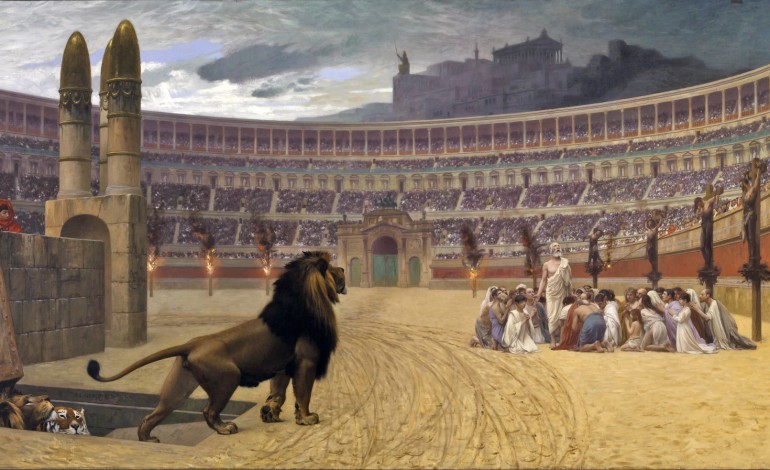
|
